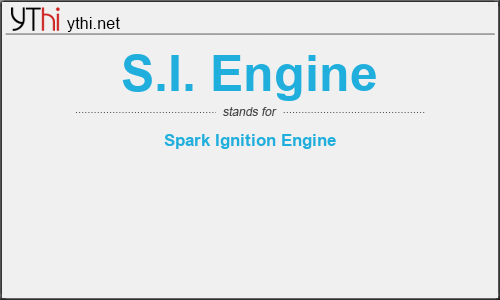What does S.I. Engine mean? What is the full form of S.I. Engine?
The full form of S.I. Engine is Spark Ignition Engine
A spark-ignition engine (SI engine) is an internal combustion engine, generally a petrol engine, where the combustion process of the air-fuel mixture is ignited by a spark from a spark plug. This is in contrast to compression-ignition engines, typically diesel engines, where the heat generated from compression together with the injection of fuel is enough to initiate the combustion process, without needing any external spark.
Spark-ignition (SI) engine downsizing is now established as a ‘megatrend’ in the automotive industry, providing as it does an affordable solution to the twin issues of reducing tailpipe CO2 emissions and improving fuel economy while providing improved driveability from gasoline engines. The ‘downsizing factor’ is here defined to be
where DF is the downsizing factor, VSweptNA is the swept volume of a naturally-aspirated engine of a given power output and VSweptDownsized is the swept volume of a similarly-powerful downsized alternative.
To the OEM the attractions of a downsizing strategy include that gasoline engine technology is very cost-effective to produce versus diesel engines (especially when the costs of the exhaust after treatment (EAT) system are included), that there are still significant efficiency gains to be made due to the losses associated with the 4-stroke Otto cycle, and that pursuing the technology does not entail investing in completely new production facilities (as would be required by a quantum shift to electric or fuel-cell vehicles, for example).
The advantages of downsizing a 4-stroke spark-ignition (SI) engine stem chiefly from shifting the operating points used in the engine map for any given flywheel torque, so that the throttle is wider-open to the benefit of reduced pumping losses. At the same time, the mechanical efficiency increases, this being defined as
S.I. ENGINE
means
Spark Ignition Engine![]()
Translate Spark Ignition Engine to other language.


Leave a Reply
You must be logged in to post a comment.